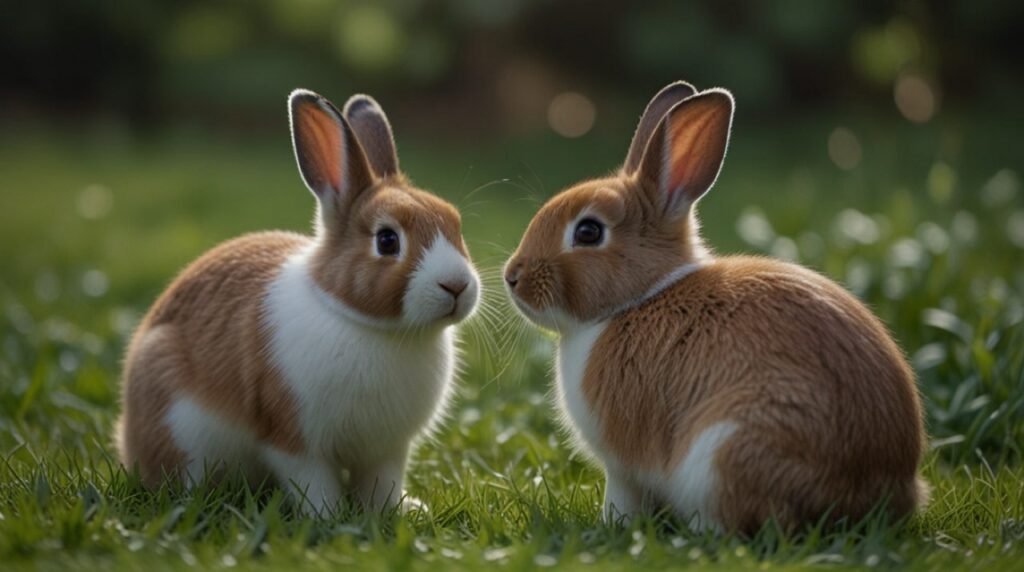So, you’ve got your rabbits together, and now you’re wondering: Did it work? Rabbit mating can seem straightforward, but if you’re new to this or just want to be absolutely sure, it’s natural to have questions. Don’t worry—you’re not alone, and I promise, we’ll make sense of it all without turning this into a biology class. Let’s break it down into the tell-tale signs, what comes next, and even what to do if things didn’t go as planned.
Rabbits and Romance: What Actually Happens During Mating
First things first, let’s set the scene. Rabbit mating isn’t exactly the slow dance under the moonlight you might be picturing. It’s more like speed dating on fast forward.
•Quick and Done: Rabbit mating usually lasts only a few seconds. Yep, seconds. If you blink, you might miss it.
•The Buck’s Signature Move: After the act, most bucks will perform what I like to call the “dramatic fall.” They’ll topple over sideways, backward, or even roll a bit. If this happens, you can probably give them a thumbs-up for effort.
•The Doe’s Role: A receptive doe will lift her hindquarters, signaling she’s ready. If she’s not in the mood, well… let’s just say you’ll know. Growling, nipping, or hopping away means she’s not feeling it today.
Sound simple? In theory, yes. But the real question is whether all this drama actually worked.
Signs That Rabbit Mating Was Successful
Okay, so the deed is done. How do you know if it worked? Here are some of the clearest signs that you’re on track for baby bunnies (kits):
1. The Buck’s Post-Mating Behavior
The falling-over move is your first clue. If the buck falls off the doe after mating, it’s usually a good sign. It means he completed his part of the process.
But What If He Doesn’t Fall?
Not every buck is a drama king. Some are more low-key and might just hop away or start grooming themselves. If you didn’t see the classic fall but everything else seemed normal, there’s still a chance it was successful. Keep an eye on the doe in the days to come.
2. The Doe’s Reaction
After mating, a successfully bred doe may show subtle changes in behavior. These can include:
•Resting More: She might seem calmer or prefer lounging.
•Avoiding the Buck: A pregnant doe often won’t be interested in mating again. If he tries, she might run off or even give him a little nip.
•Appetite Shifts: Some does start eating more (or less) in the days following a successful mating.
3. Feeling for Babies (Palpation)
If you’re eager to confirm pregnancy, you can gently feel (palpate) the doe’s abdomen around 10–14 days after mating. Here’s how to do it:
1. Place the doe on a solid surface.
2. Gently place your fingers on her lower belly.
3. Feel for tiny, grape-like lumps—those are developing kits!
Not Sure You’re Doing It Right?
No worries. This takes practice, and even experienced breeders sometimes miss the signs. If you’re unsure, a vet can confirm pregnancy with more accuracy.
4. Watch for Weight Gain
Pregnant rabbits don’t gain a ton of weight, but you might notice her looking a bit rounder by the second or third week. It’s subtle, but it’s there if you’re paying attention.
5. Nesting Behavior
Does instinctively prepare for their kits by building a nest. This involves pulling fur from their chest and belly (don’t worry, it grows back!) and arranging bedding into a cozy little haven. This usually happens closer to the end of the pregnancy, but in some cases, you might spot early nesting.
What If It Didn’t Work?
Not every mating attempt leads to pregnancy, and that’s perfectly normal. If your doe doesn’t show any of the above signs after two weeks, it’s time for Plan B (or Plan Bunny).
Tips for a Second Attempt
•Wait a Few Days: Sometimes, the doe just wasn’t ready. Give her a little time before reintroducing her to the buck.
•Switch Up the Setting: A change of scenery can make all the difference. Try a neutral area where neither rabbit feels territorial.
•Check for Health Issues: If multiple attempts fail, consult a vet to rule out any underlying problems.
The Pregnancy Timeline: What Happens Next?
So, you’re pretty sure the mating was successful—congratulations! Here’s a quick timeline of what to expect over the next month:
Day 1–14: Early Days
The embryos are developing, but you might not notice much change in the doe. She’ll go about her business as usual, with maybe a slight uptick in appetite or resting.
Day 15–28: Mid-Pregnancy
By now, you might notice subtle signs like weight gain or mood changes. Palpation during this window can confirm pregnancy.
Day 29–31: Delivery Time
Most does give birth around day 31, though it can vary by a day or two. You’ll notice her nesting behavior ramping up as the big day approaches. Be sure to provide a nesting box with soft hay or bedding.
Caring for a Pregnant Doe
Pregnancy isn’t just a big deal for humans—it’s a significant time for your doe, too. Here’s how to keep her happy and healthy:
•Nutrition Matters: A high-quality diet is crucial. Offer unlimited hay, fresh greens, and a controlled amount of pellets to ensure she’s getting the nutrients she needs.
•Minimize Stress: Pregnant does need a calm environment. Keep loud noises, curious pets, and unnecessary handling to a minimum.
•Nesting Box Prep: Introduce a nesting box by day 28. She’ll appreciate having a safe, cozy spot for her kits.
FAQs About Rabbit Mating and Pregnancy
1. How Soon Can Rabbits Mate Again?
Rabbits are fertile little creatures. A doe can technically mate right after giving birth, but this isn’t ideal for her health. Give her at least 6–8 weeks to recover before trying again.
2. Can I Keep the Buck and Doe Together During Pregnancy?
Nope. Once she’s pregnant, the doe will likely prefer some space. Keeping the buck separate helps prevent stress (and avoids a surprise second pregnancy).
3. What If She Rejects the Kits?
Occasionally, a doe might not care for her litter. If this happens, you’ll need to step in and hand-feed the kits. Consult a vet or rabbit expert for advice on how to do this properly.
The Bottom Line
Rabbit mating and pregnancy might seem mysterious at first, but once you know what to look for, it’s pretty straightforward. From the buck’s dramatic fall to the doe’s subtle behavior changes, there are plenty of clues to guide you. And if it didn’t work out this time? Don’t stress—rabbits are nothing if not persistent.
By staying patient, observant, and supportive, you’ll soon be welcoming a litter of fluffy little bunnies into the world. And trust me, there’s nothing quite like it!
References
•Rabbit.org – Rabbit Pregnancy Guide
•American Rabbit Breeders Association
•Vetstreet – Rabbit Reproduction Facts
Share

